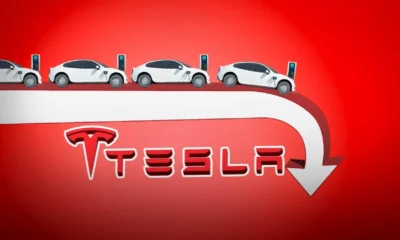Business
China’s Share Of Global EV Market Rises To 76%: How China Sidestepped EU EV Tariffs But Can It Outsmart Trump?
Published
10 months agoon

China’s EV market dominance has reached staggering heights, with its share of the global market hitting 76% in October 2024, according to the China Passenger Car Association (CPCA). This feat surely illustrates the nation’s strategic focus on EVs as a critical pillar of its economic and green transformation; however, looming Western tariffs, particularly from the U.S. could challenge its continued ascent.
Unparalleled Domestic Demand
Between January and October, China saw EV sales skyrocket to 14.1 million units, representing 69% of global EV sales.
However, this dominance is not new; in 2023, nearly 60% of new EV registrations globally were in China, as per the International Energy Agency. The figures reflect a strong domestic appetite for EVs, further strengthened by government incentives such as subsidies of up to 20,000 yuan (£2,169) for consumers trading in conventional cars.
Hence, if one were to understand this China’s massive domestic market has insulated it from some of the adverse effects of Western trade policies. The sheer scale of EV adoption within the country ensures that its manufacturers remain on a solid footing, even as external markets become harder to penetrate.
Western Tariffs. A Roadblock for Exports
Despite its internal success, China faces significant hurdles abroad.
Western markets, which include the U.S. and the EU, are the largest destinations for EVs outside of China. Yet these markets are increasingly erecting barriers to Chinese exports:
- In the U.S., President Joe Biden raised tariffs on Chinese EVs from 25% to 100% this year. Adding to this, President Donald Trump who steps into office next month has vowed to impose a further 10% levy on all Chinese imports.
- In the EU, tariffs on Chinese EVs could reach as high as 35%, up from the existing 10%, a move that Beijing has vehemently criticized.
These measures are designed to protect domestic automakers and counter China’s state-backed EV industry. However, they also threaten to limit Chinese manufacturers’ expansion in two of the most lucrative global markets.
Tesla and Russia
Interestingly, Tesla, led by Elon Musk—a Trump ally—has found much favor in China. Its sales rose by 7% in the third quarter, partly fueled by the country’s consumer subsidies demonstrating that while Chinese EV makers may face challenges abroad, foreign automakers with local manufacturing bases in China can still thrive.
Meanwhile, Russia has emerged as a surprising bright spot for Chinese automakers.
Amid Western sanctions following the invasion of Ukraine, Chinese car exports to Russia have surged by 109% over the past two years.
In contrast, exports to the U.S. have plummeted by 23% over the same period. Chinese manufacturers view Russia as an opportunity, especially since Western rivals have largely exited the market due to geopolitical risks.

Sidestepping The EU Tariffs
Even as the EU has raised tariffs on Chinese EVs to protect its domestic automakers, Chinese car manufacturers are employing an innovative strategy – shifting their focus to hybrid vehicles. Industry giants such as BYD, Geely, and SAIC are ramping up their hybrid exports to Europe, leveraging this segment as a tariff-free avenue to bolden their European market share.
Hybrids, A Clever Workaround
Hybrids, which combine electric batteries with internal combustion engines, have emerged as a strategic alternative to pure EVs. Unlike fully electric cars, hybrids are currently not subject to the EU’s increased tariffs, providing a window of opportunity for Chinese automakers to maintain a foothold in the European market.
According to the China Passenger Car Association (CPCA), exports of Chinese hybrid vehicles to Europe tripled between July and October this year, reaching 65,800 units compared to the same period in 2023.
These hybrids are designed to compete head-on with established Japanese and European players such as Toyota, Honda, Nissan, and Volkswagen, who are already feeling the pressure of declining sales.
Chinese manufacturers are also introducing a range of hybrid models tailored for European consumers:
–BYD is launching the SEAL U DM-i, its first hybrid model for Europe, alongside the Song Plus DM-i.
–Geely has plug-in hybrids (PHEVs) like the Galaxy Starship 7 and mild hybrids such as the Azkarra.
–SAIC, through its MG brand, offers models like the MG6 PHEV, MG3 HEV, and the MG EHS Plug-in Hybrid.
These vehicles are competitively priced and boast advanced features, thus making them a serious threat to traditional hybrid leaders.
The EU’s decision to impose steep tariffs on Chinese EVs stems from accusations that Beijing heavily subsidizes its EV makers, enabling them to sell at lower prices in European markets. The tariffs vary by company, with BYD facing a 17% levy, SAIC hit with 35.3%, and Geely taxed at 18.8%.
While these measures aim to protect European automakers, they have inadvertently pushed Chinese firms to double down on hybrids. However, going forward, this pivot could invite further scrutiny and potential tariffs if hybrids significantly disrupt the European automotive market.
Chinese automakers are not solely relying on exports. Many have established assembly and production facilities within Europe to mitigate tariff impacts, further reducing costs and strengthening their local presence.
Still, Why Are Chinese Hybrid Vehicles Gaining Popularity in the EU?
Chinese hybrid vehicles are carving a significant niche in the European market, fueled by their affordability, advanced features, and strategic positioning amid evolving consumer preferences and economic challenges.
Lets look at why they are resonating with European buyers-
- Cost Advantage Amid Economic Pressures – One of the primary reasons for the rise of Chinese hybrids in the EU is their relatively lower cost compared to European hybrids and electric vehicles (EVs). This affordability has become increasingly crucial in the post-pandemic era, as Europe is struggling with a cost-of-living crisis and rising interest rates. For price-sensitive buyers, Chinese hybrids offer an attractive middle ground between traditional vehicles and fully electric models.
- Feature-Packed and Modern Designs – Chinese hybrid models are known for their sleek, modern designs and advanced automotive technology, which include smart connectivity features and efficient energy management systems. These vehicles also boast improved reliability, quality, and safety ratings, appealing to European consumers who value innovation and safety.
- A Transitional Solution for EV Hesitancy – Hybrids serve as an ideal stepping stone for consumers who are hesitant to make a full transition to EVs. They combine the familiarity of an internal combustion engine with the environmental benefits of electric propulsion. Moreover, hybrids are often cheaper than EVs and can be eligible for tax breaks in several European countries, further incentivizing their adoption.
Chinese automakers, such as BYD, Geely, and SAIC, have strategically focused on hybrids to avoid high tariffs imposed on EVs by the EU. By offering feature-rich hybrid models like BYD’s Song Plus DM-i and Geely’s Galaxy Starship 7, they provide a competitive alternative to established players like Toyota, Honda, and Volkswagen.

However, while Chinese EVs have found a path forward in EU can China outsmart Trump’s proposed EV tariffs?
Under President Biden, tariffs on Chinese EVs already rose to 100%, citing concerns over subsidized exports. Trump’s proposed policies could further escalate trade tensions.
Chinese EVs account for less than 1% of U.S. EV imports, making the American market less critical for their growth. However, the potential loss of a growing segment remains a concern.
Industry experts suggest that Trump’s policies could hinder overall EV market growth in the U.S., potentially reducing EV adoption rates to 28% by 2030 from the previously forecasted 33%.
While protectionist policies create hurdles, they also open doors for negotiation. Chinese automakers could leverage their capacity to create jobs and invest in U.S.-based facilities, aligning with Trump’s focus on boosting the domestic economy.
China’s EV dominance stems from years of strategic investment in battery technology, supply chains, and green policies. However, it is clear that its global ambitions face headwinds. Tariff wars could push Chinese automakers to seek alternative markets, improve cost efficiencies, or invest in overseas production facilities to circumvent duties.
So what could strategies could Chinese EV makers employ?
Leading firms like Xpeng and BYD are establishing production plants in Europe, Mexico, and other regions to bypass tariffs. This approach not only reduces costs but also contributes to local economies, potentially softening resistance.
Chinese EV makers are shifting their focus to markets in Africa, Southeast Asia, and even Russia, where demand for cost-effective vehicles remains strong.
Chinese EVs are recognized for their superior technology, including long driving ranges, self-driving capabilities, and integrated digital features. These innovations position them as formidable competitors globally, despite tariff challenges.
Therefore, whether China can outmaneuver Trump’s promised levies or the EU’s protective policies will depend on its ability to innovate and adapt to shifting global trade dynamics. The coming years will test whether its reliance on domestic demand and select export markets like Russia can sustain its momentum.
China’s EV market continues to expand and dominate, but its journey to global supremacy is far from assured.
You may like
-


PM Trudeau Not Willing To Back Down To Trump’s ‘Unfair Tariffs’. How Difficult Will It Be For Trudeau’s Successor To Safeguard Canada’s Economy? What Are Canada’s Options?
-


Trump 2.0. Brace for Turbulence in Global Financial Markets—Indian Markets Not Spared. What’s Next for Stocks, Bonds, Gold, Interest Rates, and Oil Prices?
-


Trump’s Fresh Tariff Threats To EU, China And Halt On Offshore Wind Power Leases Shake European Companies
-


India Sees Trouble On Two Fronts, US Sanctions On Russian Oil And China’s Export Curbs—What Can India Do To Ride The Wave?
-


Tesla In Trouble? Annual Deliveries Dip For The First Time, But China Sales Hit Record Highs—Can Elon Musk’s EV Giant Bounce Back?
-


JSW Group Revving Up EV Ambitions. Talks With Chinese Giants Geely And BYD Underway. Will It Succeed?

